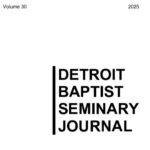Kevin DeYoung’s The Hole in Our Holiness: A Review
 A few months ago I expressed some fairly strong reservations about a nefarious variation of “Gospel-Centered” sanctification that has captured the attention of a number of conservative evangelical luminaries—a preach-the-Gospel-to-yourself, squeeze-your-eyes-tight-and-think-really-hard-about-justification method of propelling oneself to holiness without any discipline, self-denial, effort, or obedience (cuz that’s how them legalists do sanctification).
A few months ago I expressed some fairly strong reservations about a nefarious variation of “Gospel-Centered” sanctification that has captured the attention of a number of conservative evangelical luminaries—a preach-the-Gospel-to-yourself, squeeze-your-eyes-tight-and-think-really-hard-about-justification method of propelling oneself to holiness without any discipline, self-denial, effort, or obedience (cuz that’s how them legalists do sanctification).
In this post, I’d like to put on a happy face and make a positive recommendation of an accessible, contemporary, evangelical work that captures a much more holistic picture of the Bible’s teaching on sanctification—a book that does not neglect the motivating role of justification in personal holiness, but one that concentrates more promisingly on regeneration as the energy that fuels personal holiness.
In his book The Hole in Our Holiness, Kevin DeYoung argues that the Gospel involves more than a new standing in Christ; it also involves a new creation. And when we emphasize the former to the neglect of the latter, personal holiness inevitably suffers. This is the hole in our holiness. It starts as a noble effort to rid justification of every vestige of good works, but expands to “assume that good works will invariably flow from nothing but a diligent emphasis on the gospel,” and culminates in a bad case of “nomophobia” or the fear of laws (p. 55). People with this disorder, DeYoung suggests, “make every imperative into a command to believe the gospel more fully…and faith becomes the one thing we need to be better at. If only we really believed, obedience would take care of itself. No need for commands or effort.”
The problem with this approach, DeYoung asserts on the same page, is that “the Bible does not reason this way. It has no problem with the word ‘therefore.’ Grace, grace, grace, therefore, stop doing this, start doing that, and obey the commands of God. Good works should always be rooted in the good news of Christ’s death and resurrection, but I believe we are expecting too much from the ‘flow’ and not doing enough to teach that obedience to the law—from a willing spirit, as made possible by the Holy Spirit—is the proper response to free grace.”
As a dispensationalist I would quibble with DeYoung’s “third use of the Mosaic Law” as something that continues in the present dispensation. But as DeYoung himself points out, we agree in principle that there exists a transcendent law of God that functions most emphatically as a manifest guide for Christian behavior. It is a guide that instructs us to mortify sin, to put off the old and put on the new, to fight the good fight, to strive, to run, to discipline the body, to press forward and strain, to make every effort, to toil, to struggle with all our energy, to conquer, and to overcome (pp. 88–89). And where do we find the energy for this monumental effort? We find the energy in our new life in Christ! By means of definitive sanctification and new birth God has broken the grip of total depravity and rendered us capable of walking in holiness—not perfection, mind you, but real holiness nonetheless. And so we are called upon to become what we are (chap 7).
So what does this look like? Firstly, it involves the full use of the ordinary means of grace (prayer, reading Scripture, and the regular celebration of our union with God’s people and with Christ himself in the rites and functions of the local church). And secondly, it involves me constructing a plan to avoid sin and cultivate holiness in the peculiar milieu where I live and work. To illustrate the latter, DeYoung singles out the pervasive problem of sexual immorality and constructs a biblical strategy for avoiding it. His strategy (all of chapter 8), easily the best short treatment I have ever seen on this topic, is especially directed especially to an unmarried, late-teen/twenty-something audience. If you are in this category or are a parent of someone in this category, buy the book and read this chapter without delay (but preferably the whole book, too).
In the interest of full disclosure, I have a handful of minor quibbles with DeYoung’s work (e.g., his use of the Mosaic Law mentioned above and also his curious emphasis on “positional” sanctification in chaps 6–7 that in some ways undercuts his major argument even as he makes it). But in all, this book offers an extremely fine alternative to the “Gospel-Centered” (or more accurately, the “justification-only”) model that threatens the modern evangelical movement with premature death by nomophobia.
Tolle Lege



Thanks for this review!
Thanks for the revue. When I saw the title of this blog post, my interest was peaked, as I recently read this book. Like you, I was encouraged to see an intentional step made by a contemporary evangelical to address this area of personal holines.
DeYoung actually preached one of the chapters of this book (Chapter 6, “Spirit-powered, Gospel-driven, Faith-fueled Effort”) in a general session of the 2012 T4G Conference. And while I don’t want to be perceived simply as a de facto critic of all things T4G, I believe the book illustrates some shortcomings to his approach and to conservative evangelicalism as a whole. First, the essence of personal holiness (or God’s holiness, for that matter)is rooted in separation, or separateness. I could list the standard separation texts, but to be holy demands a separating from and a separating to. As DeYoung wrote and spoke (well, I might add) on the need for personal holiness, the lion’s share of the message focused on the conforming to God, but much less attention was paid to the necessary separation from. I could be wrong, but I didn’t see or hear the word “separation”, even in a personal sense (I may be mistaken here, but my point was that personal separation was not clearly and unequivocably pronounced). I think that because the historical stripe of Christianity, i.e. fundamentalism, has for so long been defined by our separation, there is an unwillingness to talk openly about the need for separation for fear of being lumped into the old time “fundamentalists.”
The second thing I noticed was the amount of modern cultural allusions he made throughout the book. Call it being young, but it was clear that he had a pulse on what our culture deems popular or entertaining. Making several references to movies, music (I know, the standard fodder for us separatists) and trends, all to illustrate his biblical points, showed his own personal knowledge of the elements of modern worldliness that demand personal separation from (unfortunately I don’t see much energy from many Christians given to being “innocent concerning evil.” Frankly, it would be refreshing if my congregation was not familiar with the content of a Lady Gaga song or the Hunger Games).
Combine both those things – what isn’t said about personal separation and what is evidenced by the speaker’s pop-culture IQ – and you have, in my humble opinion, an implicit approval at the status quo of what he is preaching against. So long as you are balancing your worldly entertainment with a healthy dose of worship and Bible study, and so long as intellectual assent is given to the objectionable elements so that they are recognized but not approved, then we’re ok.
What DeYoung did – perhaps unwittingly- was put a stamp of approval for a muddled pattern of personal holiness.
Again, I thought the message was both timely and biblical, just incomplete. And that has been our concern for those in his camp from day one, right?
And sorry for the spelling errors in the previous post (revue? holines? really?); I’m sure my TRM professor would cringe at such a glaring oversight!
Mike,
Thanks for the pushback. It seems to me that DeYoung works pretty hard to avoid the polar extremes of (1) isolation from the world and (2) the embrace of worldliness. And he does a good job exposing the theological errors that some use to justify and even to promote licentiousness.
Your criticism of his applications may have warrant, but I think some of the concern can be chalked up to the nature of the book, much of which is deconstructive. DeYoung is stimulating the consciences of readers that have in many cases been dulled to tolerate expressions of adultery and fornication and prostitution and pornography because they are “realities” that are part of “being in the world.” And distasteful though it may have been, he needed some familiarity with that worldview to explain why it is wrong. Sometimes that’s necessary: I daresay that you yourself must have had at least some exposure to Lady Gaga to be able to say, as you did, that “it would be refreshing if my congregation was not familiar with the content of a Lady Gaga song.” That’s part of what parents and pastors have to do sometimes.
Does DeYoung show evidence of being “overexposed” to the world? Maybe. It happens to all of us despite our best efforts. My wife and I have “vetted” movies for the family and have seen some things that we would rather have never seen—gross sins that are either celebrated, depicted gratuitously/seductively, or simply rendered “ordinary.” We take this risk because one of the ways that we help small children stay innocent about sin is by delaying or preventing their exposure to sin.
At the same time, as my kids have grown older I’ve come to the realization that innocence about sin and ignorance about sin are not the same thing. Innocence concerning sin is an ideal to place always before ourselves, but total ignorance about sin is neither possible nor even desirable—and we can do our kids a disservice by pretending that it is. DeYoung is targeting an audience that is neither innocent nor ignorant of sin—and if we have properly functioning churches, this kind of believer is regularly in our midst. And I think DeYoung does a good job helping us to minister to that kind of person. Not a perfect job, by any stretch, but a good job.